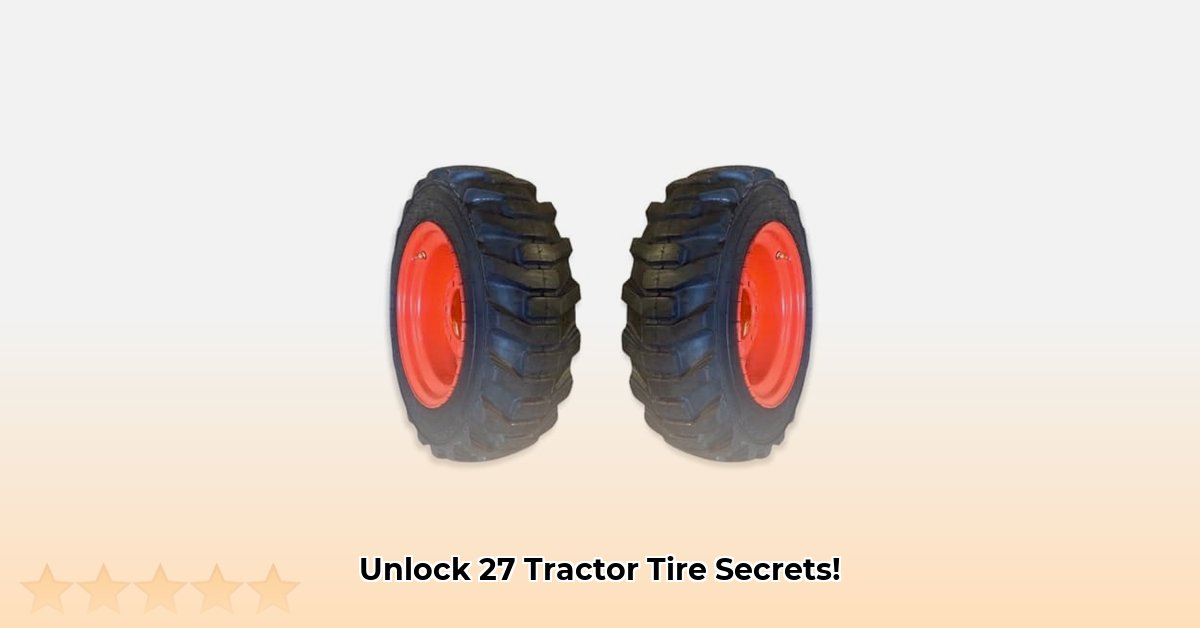
Choosing the right tractor tires is crucial for farm efficiency and profitability. The 27x8.50-15 size, while less common than others, presents unique considerations. This guide explores this niche market, providing actionable insights and future trend forecasts for informed decision-making. For more information on tractor tire sizes and rims, check out this helpful resource: Tractor Tire Guide.
Decoding the 27x8.50-15 Tire Size
The designation "27x8.50-15" provides vital information about the tire's dimensions. "27" represents the overall diameter in inches, "8.50" denotes the width in inches, and "15" specifies the rim diameter in inches. Understanding these measurements is vital for proper fit and performance. Incorrect sizing can lead to reduced efficiency and potential damage.
Tread Patterns: Optimizing Traction for Diverse Terrains
Tire tread patterns are designed for specific terrains. Aggressive treads, featuring deep lugs, provide superior grip in muddy or soft soil conditions. However, they may consume more fuel on paved surfaces due to increased rolling resistance. Conversely, smoother tread patterns excel on hard surfaces, offering better fuel economy but potentially reduced traction on loose soil. The optimal choice depends heavily on your typical working environment. What percentage of your work is in fields versus on roads? This question directly informs tire selection.
Tire Construction: Balancing Durability and Budget
Radial and bias-ply tires offer distinct advantages. Radial tires, known for their strength and longevity, are a long-term investment that delivers superior performance and a longer lifespan. However, they typically command a higher initial cost. Bias-ply tires, while less durable, provide more budget-friendly options, often suitable for lighter-duty applications. The decision hinges on your budget and the anticipated lifespan of the tires. Is long-term cost-effectiveness prioritized over immediate expenditure? This is a key factor in your choice.
Soil Compaction: Minimizing Environmental Impact
Soil compaction, caused by heavy machinery, negatively impacts water absorption and root growth, thereby reducing crop yields. Using wider tires distributes the tractor's weight over a larger area, minimizing compaction. This is a critical factor in promoting sustainable farming practices and soil health.
Fuel Efficiency: Minimizing Operational Costs
Tire pressure significantly influences fuel efficiency. Under-inflation increases rolling resistance, resulting in higher fuel consumption. Over-inflation, conversely, can damage the tire and decrease traction. Regular pressure checks are paramount for maximizing fuel efficiency and minimizing operational costs. Have you considered the long-term fuel savings associated with optimal tire pressure?
Cost Considerations: Balancing Upfront Investment and Long-Term Savings
The initial cost of 27x8.50-15 tires varies based on brand, construction, and features. Remember to factor in the total cost of ownership, weighing the initial investment against potential replacement costs and long-term savings in fuel efficiency and reduced soil compaction. A higher upfront cost might translate to substantial long-term savings.
Future Trends: Innovation in Agricultural Tires
The agricultural tire industry is constantly evolving. Expect future innovations in materials, tread designs, and construction techniques focused on greater efficiency and sustainability. Advancements promise to further minimize soil compaction and enhance fuel economy.
Choosing the Right Tires: A Practical Guide
Selecting the correct tires involves a systematic approach:
- Assess Operational Needs: Evaluate your typical terrain, fuel efficiency requirements, and budget limitations.
- Investigate Available Options: Research different brands, models, and online reviews to compare specifications and gather farmer feedback.
- Seek Expert Advice: Consult local agricultural equipment dealers for personalized recommendations tailored to your specific needs and regional conditions.
- Calculate Total Cost of Ownership: Consider the initial price alongside replacement costs and long-term implications for fuel consumption and soil health.
Summary Table: Key Tire Characteristics
| Feature | Aggressive Tread | Smooth Tread | Radial Construction | Bias-Ply Construction |
|---|---|---|---|---|
| Traction | Excellent | Good | Excellent | Good |
| Fuel Efficiency | Lower | Higher | Higher | Lower |
| Soil Compaction | Higher | Lower | Lower | Higher |
| Cost | Higher | Lower | Higher | Lower |
Navigating the 27x8.50-15 Niche Market
Finding 27x8.50-15 tires can present challenges due to limited availability. Online retailers specializing in niche tire sizes may be the best resource. Be prepared for potentially longer lead times and potentially higher costs. Always check availability before committing to a purchase. The smaller market size could necessitate flexibility in size selection if your preferred option proves unavailable.
Key Considerations for Selection
Choosing wisely requires assessing key factors:
- Load Index: This rating indicates the maximum weight the tire can support. Ensure it aligns with your tractor's weight and load requirements.
- Speed Rating: Although less critical for tractors, consider a higher rating if speed is a frequent necessity.
- Manufacturer Reputation: Select a renowned manufacturer known for producing reliable and durable tires. Online reviews and farmer recommendations can serve as valuable sources of information.
Conclusion
Investing in the right 27x8.50-15 tractor tires is a strategic move that impacts efficiency, cost, and environmental sustainability. Thorough research, careful consideration of individual needs, and awareness of market limitations are crucial for informed decision-making. Remember that a seemingly small detail like tire selection can have extensive implications on your farm's success and long-term performance.